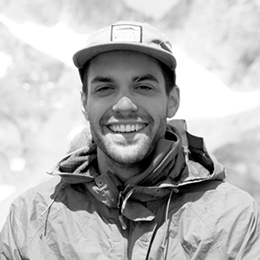
“I started backpacking and cycling at a young age and haven’t really stopped since. These gear-based passions made me very aware of the objects I was using. I found ceramics my senior year in high school which opened me up to the arts and creating. After that, the idea of blending my passion took hold.”
—Patrick Shields, IDSA, 2016 Central District Student Merit Award Winner
Patrick Shields, IDSA, hit the ground running when he graduated from Kendall College of Art and Design (KCAD) in Grand Rapids, MI with a bachelor’s degree in industrial design. He’s now an associate designer at the state-of-the-art Newell Brands Design Center—also in Michigan. Turns out, the connection was made via IDSA. Shields learned about Newell while working on West Michigan Desk Week with Paul Martus, IDSA—a senior designer at Newell who was also the IDSA Michigan Chapter Chair.
Shields’ new employers were impressed with the hands-on internships he had completed at Bissell and Chervon—working on a wide range of products from vacuums to power tools to lawn products in major brands such as Craftsman, Husky and Kobalt. Growing up in the state with the highest concentration of industrial designers also had an effect. “I’ve had a lot of time and opportunity to immerse myself into the community,” he says. “Staying in west Michigan was the best decision I could have made for my academic career.”
At the 2016 Central District Design Conference at the Carnegie Museum of Art in Pittsburgh—Shields won the IDSA Student Merit Award. He presented 3D-printed, porcelain coffee cups. He says Hex blended two key components of his life—ceramics and design. He also highlighted the Bissell 3-in-1 Stair Tool, and Sherpa, a bicycle tire changing tool. But it was from the fourth project that he learned the most. “HLS (Hiker Location System) showed me how powerful design can be if you focus on the bigger picture,” he explains. “HLS looks at hiker safety from a zoomed out perspective and analyzes the relationships among search and rescue teams; hikers; and the market in which they exist—forming a complete view. It showed me that if you are only focused on the object itself, it’s so easy to come out with a short sighted, short lived—and in terms of hiker safety—profit-driven, disempowering and dangerous result.”
“In the beginning I chose ID to make the things that I loved,” he says. “Hiking boots, gear, bikes—all things useful, adventurous. Seeing how people form relationships with these kinds of objects is extremely interesting to me. I started backpacking and cycling at a young age and haven’t really stopped. These gear-based passions made me very aware of the objects I was using. I found ceramics my senior year in high school which opened me up to the arts and creating. After that, the idea of blending my passion took hold.” Now, he’s inspired by all things—such as an old, used, red GT mountain bike “which really sparked my attention to objects,” and Grand Rapids’ designer Joey Ruiter’s Inner City Bike, “which shows how a product can connect its past to its present.”
“I think industrial design is very important the more we realize the effects of our industry—good and bad,” says Shields. “But I think design principles are even more important than any one discipline.” Looking ahead, Shields would consider graduate school. “I’m very interested in furthering my core industrial design skills, management—something systems related—or even focusing on a body of work that explores abstraction, advanced design tools and traditional materials. I’m also interested in looking past the goods and services we develop as designers. While still conscious of products, I’m very interested in the systems in which they exist.”